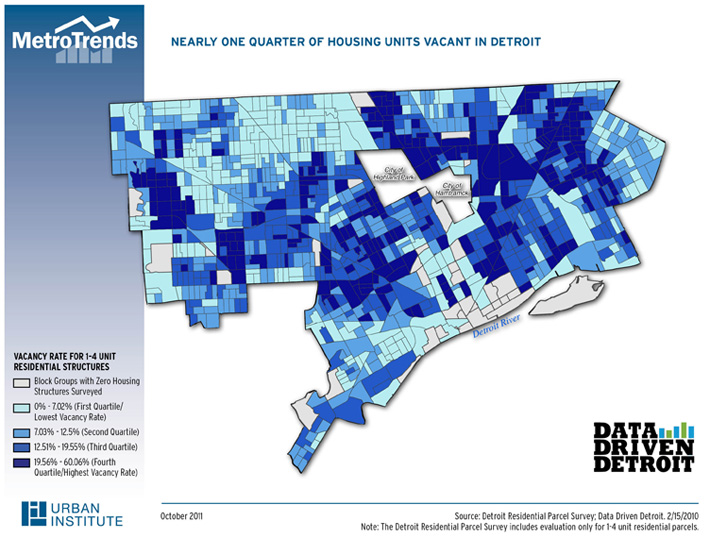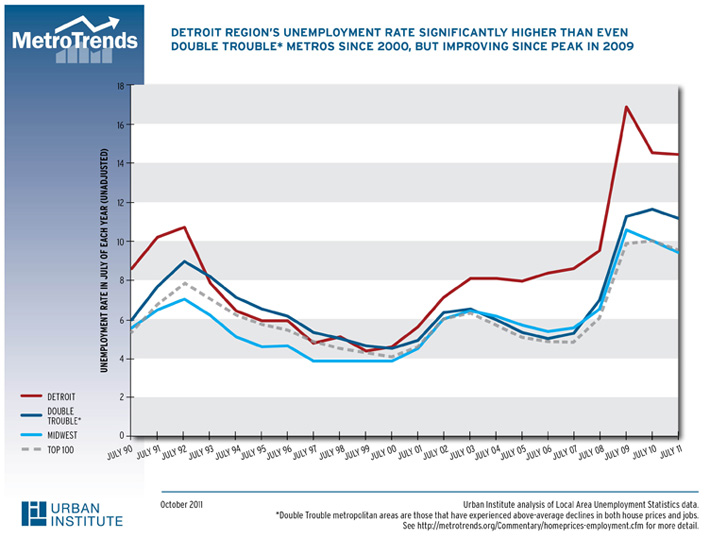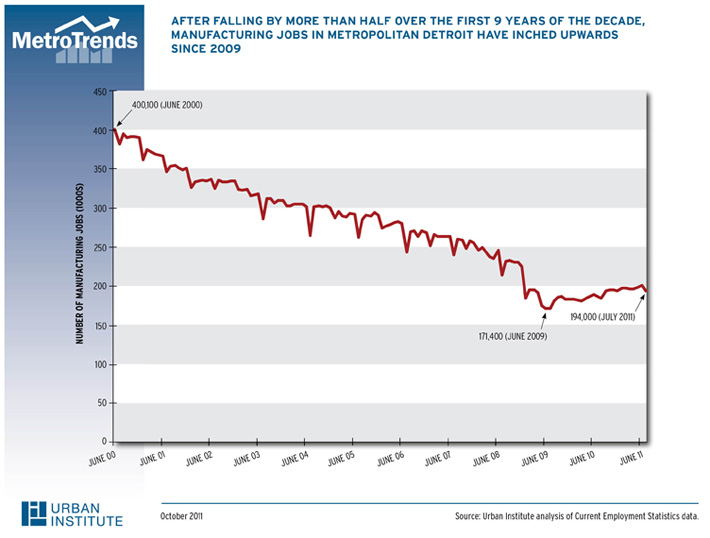
|
|
Metropolitan Spotlights Our metropolitan spotlights focus on selected metros, showing how they're faring relative to others in their region and nationally. In Wake of Detroit's Disastrous Past, Envisioning Greener PasturesUnemployment at 14.2%. Average annual earnings down $2,200 since 2005. Nearly a 64% decline in mortgage originations since 1997. House prices shattered. This is a picture of the Detroit metropolitan area, ravaged not primarily by the Great Recession and housing crash, but by the collapse of the auto and auto-parts manufacturing industry. These metro-wide statistics soften the grim reality in Detroit proper, where the unemployment rate in 2010 stood at a crushing 29%. It has not helped Detroit that middle-class families-both white and black-left the city in droves. A city that once numbered 1.8 million residents now stands at just over 700,000. Detroit's population has declined by more than 200,000 people (25%) just since 2000. In the same time span, the number of single mothers with children has fallen by 30%. Consequently, 23% of the 139-square-mile city lay vacant in 2010, with the number of vacant housing units more than doubling since 2000. It is easy to become mired in the misery of these numbers, but the crucial task at hand for Detroit is to determine a path forward. Among the many challenges facing Detroit, two stand out-1) how to restructure the economy in the post-auto industry climate, and 2) how to address the disconnect between the city's large footprint and its greatly diminished populace. Clearly Detroit can no longer rely on one industry for its prosperity. However, early signs suggest that manufacturing jobs may be coming back. Current Employment Statistics data show that manufacturing jobs were in free fall for the first nine years of the last decade, dropping from 400 thousand in June 2000 to 171 thousand in June 2009. Since then, manufacturing jobs have been creeping upwards, and this past June they reached above 200 thousand for the first time since 2008. Data Driven Detroit (D3), a partner with the Urban Institute in the National Neighborhood Indicators Project is a data intermediary and research organization in Detroit dedicated to making high quality evidence a centerpiece in local decision-making. D3's Kurt Metzger explains that jobs in the region peaked in June for motor vehicle and parts manufacturing. Manufacturing jobs have since fallen below 200 thousand again, but recent labor agreements reached by General Motors and Ford should spur additional hiring. The unemployment rate is declining as well, from 14.9% in 2009 to 12.9% in August 2011 (preliminary). In fact, this is in line with a trend in declining unemployment in metropolitan areas hit hard by both the housing crisis and the jobs crisis-so-called Double Trouble metros. Providing services across 139 square miles is expensive, particularly when such large gaps exist between clusters of occupied housing. To address this issue and others, Mayor David Bing initiated the Detroit Works Project in 2010 to "create a collective vision for Detroit's future at the neighborhood, city and metropolitan scale." Crucial to this effort is the inclusion of all sectors of Detroit life in the on-going comprehensive planning process-government, business, non-profits, and community groups. Similarly, the Community Development Advocates of Detroit outlined a radical approach to rethinking the future of Detroit's neighborhoods. CDAD worked with Detroit community development organizations and professionals to develop recommendations for how to revitalize Detroit's neighborhoods, resulting in a Neighborhood Revitalization Strategic Framework The 10 typologies cover residential, commercial, and industrial areas, and create a new category-Greenscapes-to encompass areas of any type with few or no remaining residents. These Greenscape areas, according to CDAD, "should be totally reinvented for different purposes," such as nature parks or tree-lined thoroughfares connecting more inhabited neighborhoods. The residential typologies include both high- and low-density residential neighborhoods, slating particularly low-density neighborhoods for what they term urban homesteads-"country living in the city!" In fact, many remaining residents in low-density areas are already growing gardens in their neighbors' vacated land next door. A New York Times opinion piece describes how many Detroiters see food as the key to success, a unifying force among and between African-Americans and whites. CDAD envisions converting vacant land and industrial buildings into green job zones, home to economic generators such as fish hatcheries and hydroponic gardens. These areas would act as buffers between residential and natural areas and heavier industrial areas. The other typologies include more traditional downtown sectors and shopping zones. For each typology, CDAD has developed a vision and tailored strategies for moving from the present state to that vision. All of these strategies include close collaboration with all stakeholders, whether they are businesses, government, non-profits, or residents. In the wake of disastrous circumstances, Detroit has the opportunity to redefine itself. Detroit-once a mighty industrial city and economic engine for the country-could become a leaner, greener city known for innovating in green technology and providing more green space for its residents. To do so, Detroit must listen to what its people want their city to be, and exhibit the political will to implement the plan the city-wide community agrees on. |
Share
Feedback Metropolitan Spotlights Related Resources |






